Financial Reporting and International Financial Reporting Standards
VerifiedAdded on 2023/06/15
|15
|4496
|449
AI Summary
This report discusses financial reporting, regulatory frameworks, and corporate governance using J. Sainsbury as a case study. It also covers the benefits of IAS and IFRS, and provides detailed interpretations of financial statements and fiscal ratios.
Contribute Materials
Your contribution can guide someone’s learning journey. Share your
documents today.
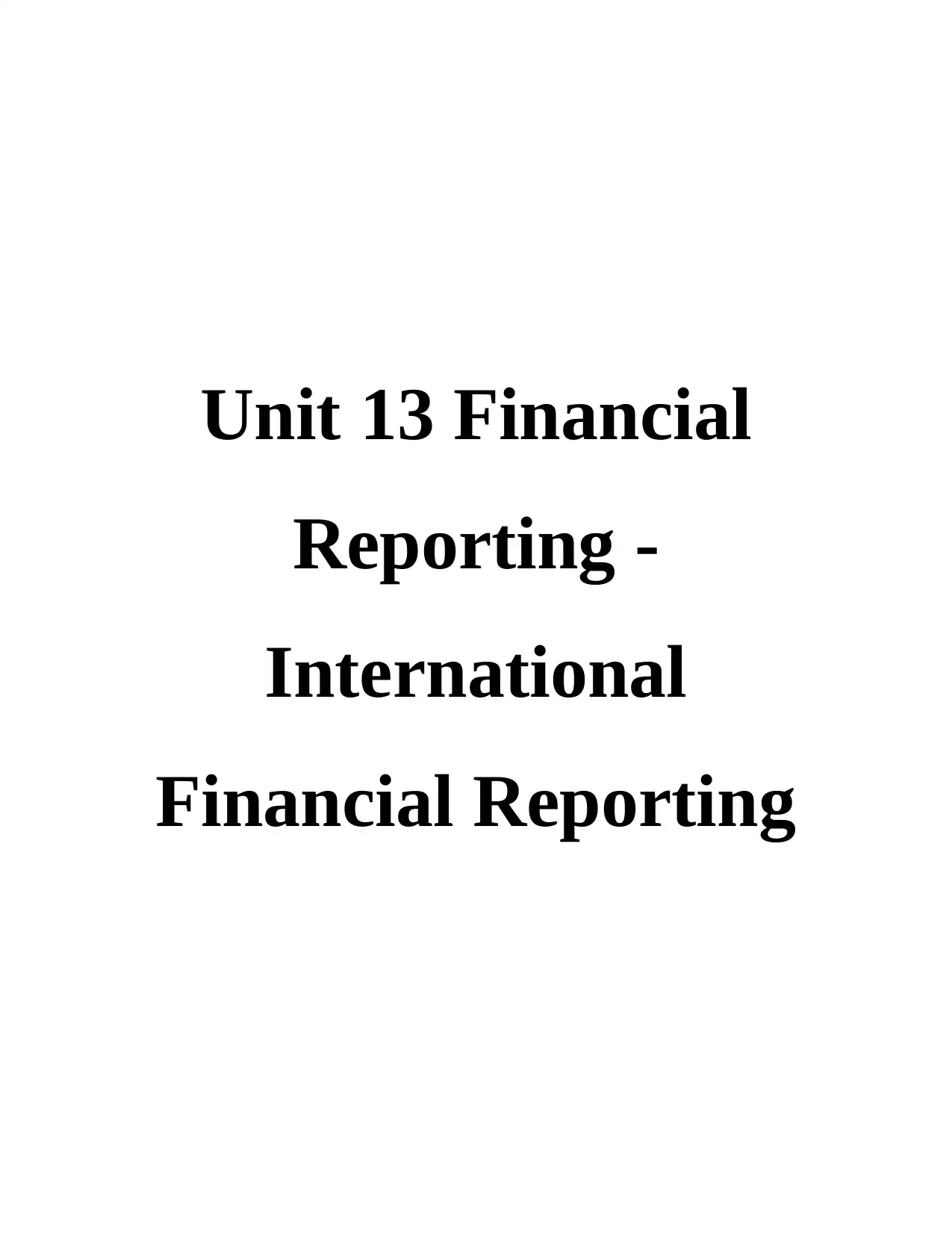
Unit 13 Financial
Reporting -
International
Financial Reporting
Reporting -
International
Financial Reporting
Secure Best Marks with AI Grader
Need help grading? Try our AI Grader for instant feedback on your assignments.
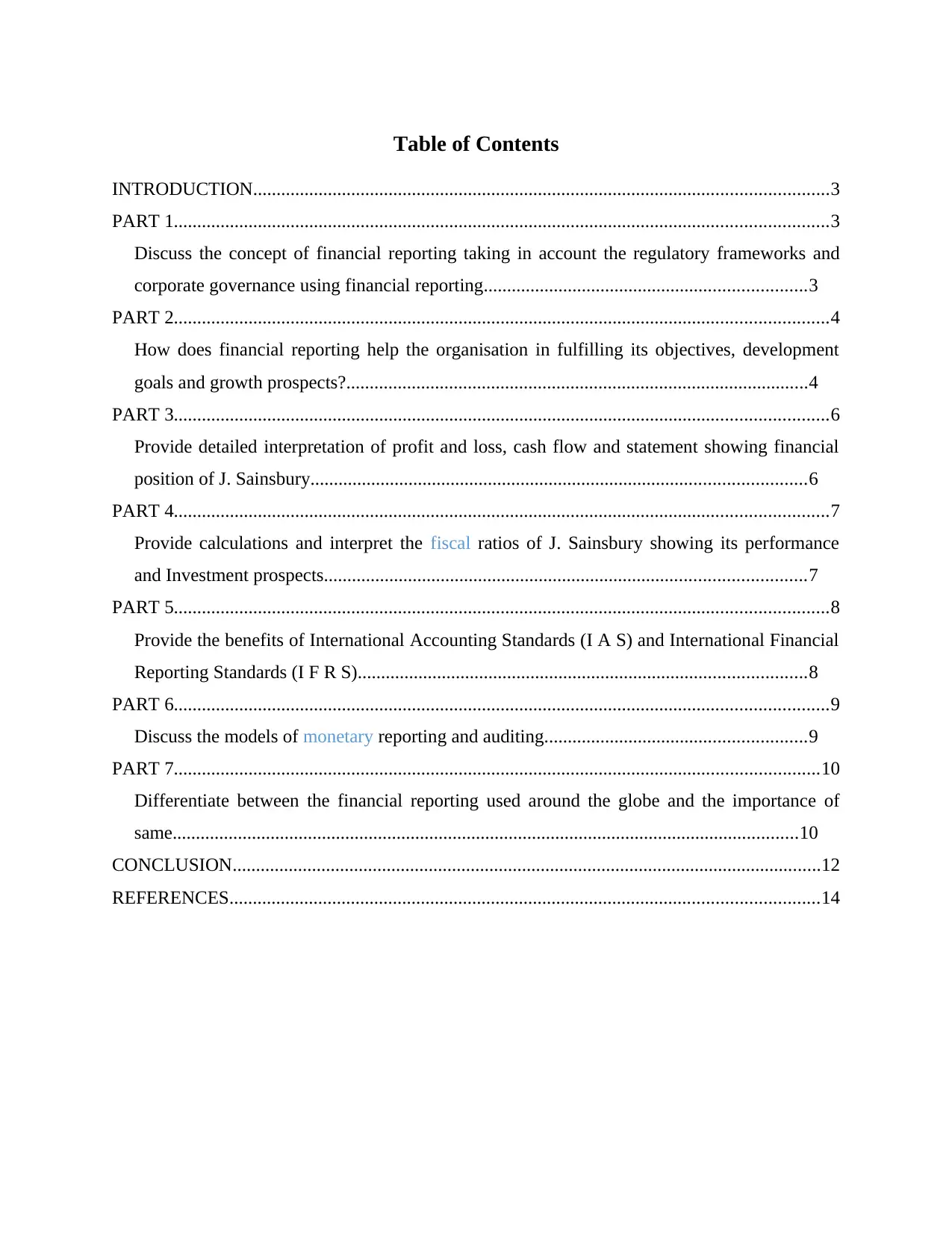
Table of Contents
INTRODUCTION...........................................................................................................................3
PART 1............................................................................................................................................3
Discuss the concept of financial reporting taking in account the regulatory frameworks and
corporate governance using financial reporting.....................................................................3
PART 2............................................................................................................................................4
How does financial reporting help the organisation in fulfilling its objectives, development
goals and growth prospects?...................................................................................................4
PART 3............................................................................................................................................6
Provide detailed interpretation of profit and loss, cash flow and statement showing financial
position of J. Sainsbury..........................................................................................................6
PART 4............................................................................................................................................7
Provide calculations and interpret the fiscal ratios of J. Sainsbury showing its performance
and Investment prospects.......................................................................................................7
PART 5............................................................................................................................................8
Provide the benefits of International Accounting Standards (I A S) and International Financial
Reporting Standards (I F R S)................................................................................................8
PART 6............................................................................................................................................9
Discuss the models of monetary reporting and auditing........................................................9
PART 7..........................................................................................................................................10
Differentiate between the financial reporting used around the globe and the importance of
same......................................................................................................................................10
CONCLUSION..............................................................................................................................12
REFERENCES..............................................................................................................................14
INTRODUCTION...........................................................................................................................3
PART 1............................................................................................................................................3
Discuss the concept of financial reporting taking in account the regulatory frameworks and
corporate governance using financial reporting.....................................................................3
PART 2............................................................................................................................................4
How does financial reporting help the organisation in fulfilling its objectives, development
goals and growth prospects?...................................................................................................4
PART 3............................................................................................................................................6
Provide detailed interpretation of profit and loss, cash flow and statement showing financial
position of J. Sainsbury..........................................................................................................6
PART 4............................................................................................................................................7
Provide calculations and interpret the fiscal ratios of J. Sainsbury showing its performance
and Investment prospects.......................................................................................................7
PART 5............................................................................................................................................8
Provide the benefits of International Accounting Standards (I A S) and International Financial
Reporting Standards (I F R S)................................................................................................8
PART 6............................................................................................................................................9
Discuss the models of monetary reporting and auditing........................................................9
PART 7..........................................................................................................................................10
Differentiate between the financial reporting used around the globe and the importance of
same......................................................................................................................................10
CONCLUSION..............................................................................................................................12
REFERENCES..............................................................................................................................14
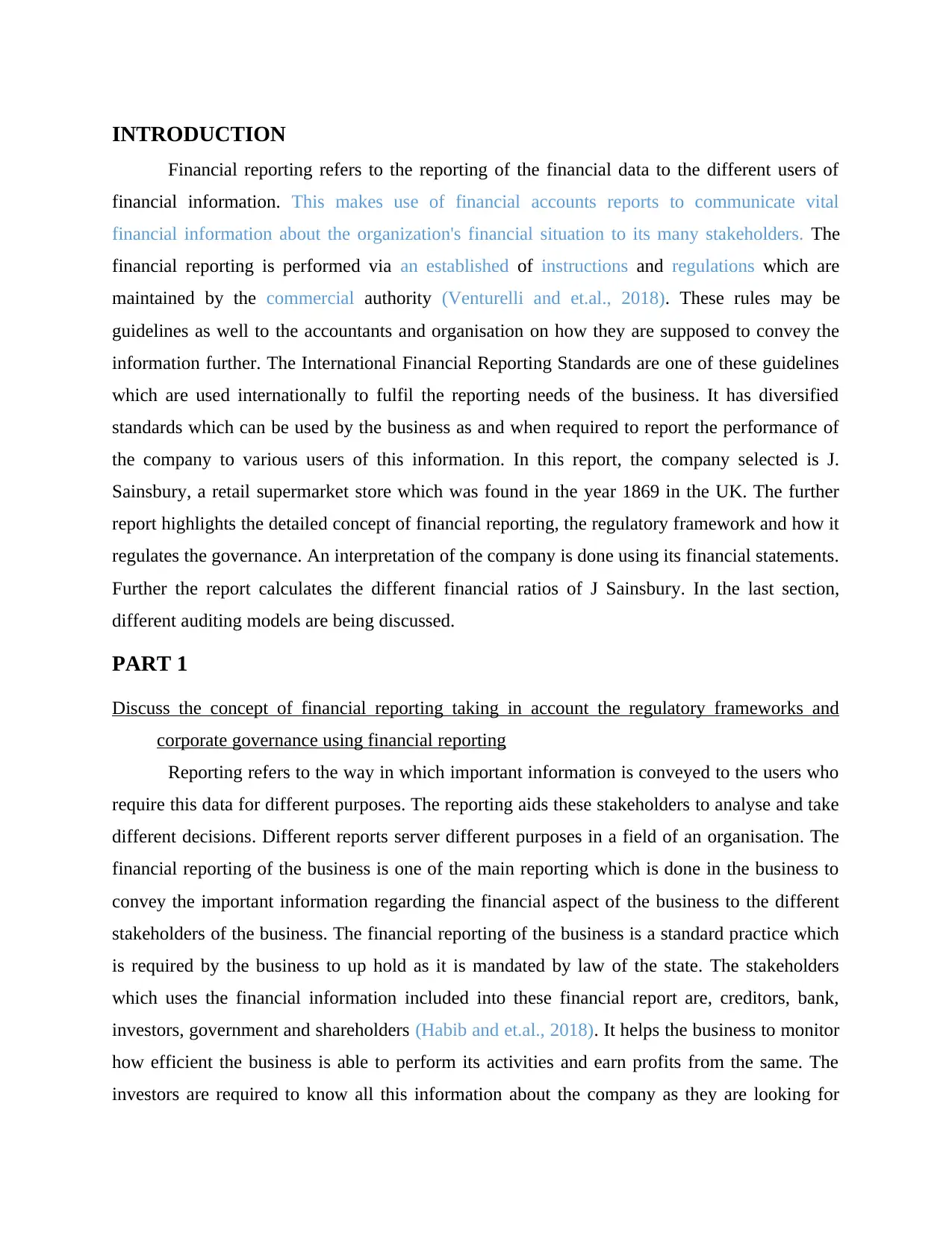
INTRODUCTION
Financial reporting refers to the reporting of the financial data to the different users of
financial information. This makes use of financial accounts reports to communicate vital
financial information about the organization's financial situation to its many stakeholders. The
financial reporting is performed via an established of instructions and regulations which are
maintained by the commercial authority (Venturelli and et.al., 2018). These rules may be
guidelines as well to the accountants and organisation on how they are supposed to convey the
information further. The International Financial Reporting Standards are one of these guidelines
which are used internationally to fulfil the reporting needs of the business. It has diversified
standards which can be used by the business as and when required to report the performance of
the company to various users of this information. In this report, the company selected is J.
Sainsbury, a retail supermarket store which was found in the year 1869 in the UK. The further
report highlights the detailed concept of financial reporting, the regulatory framework and how it
regulates the governance. An interpretation of the company is done using its financial statements.
Further the report calculates the different financial ratios of J Sainsbury. In the last section,
different auditing models are being discussed.
PART 1
Discuss the concept of financial reporting taking in account the regulatory frameworks and
corporate governance using financial reporting
Reporting refers to the way in which important information is conveyed to the users who
require this data for different purposes. The reporting aids these stakeholders to analyse and take
different decisions. Different reports server different purposes in a field of an organisation. The
financial reporting of the business is one of the main reporting which is done in the business to
convey the important information regarding the financial aspect of the business to the different
stakeholders of the business. The financial reporting of the business is a standard practice which
is required by the business to up hold as it is mandated by law of the state. The stakeholders
which uses the financial information included into these financial report are, creditors, bank,
investors, government and shareholders (Habib and et.al., 2018). It helps the business to monitor
how efficient the business is able to perform its activities and earn profits from the same. The
investors are required to know all this information about the company as they are looking for
Financial reporting refers to the reporting of the financial data to the different users of
financial information. This makes use of financial accounts reports to communicate vital
financial information about the organization's financial situation to its many stakeholders. The
financial reporting is performed via an established of instructions and regulations which are
maintained by the commercial authority (Venturelli and et.al., 2018). These rules may be
guidelines as well to the accountants and organisation on how they are supposed to convey the
information further. The International Financial Reporting Standards are one of these guidelines
which are used internationally to fulfil the reporting needs of the business. It has diversified
standards which can be used by the business as and when required to report the performance of
the company to various users of this information. In this report, the company selected is J.
Sainsbury, a retail supermarket store which was found in the year 1869 in the UK. The further
report highlights the detailed concept of financial reporting, the regulatory framework and how it
regulates the governance. An interpretation of the company is done using its financial statements.
Further the report calculates the different financial ratios of J Sainsbury. In the last section,
different auditing models are being discussed.
PART 1
Discuss the concept of financial reporting taking in account the regulatory frameworks and
corporate governance using financial reporting
Reporting refers to the way in which important information is conveyed to the users who
require this data for different purposes. The reporting aids these stakeholders to analyse and take
different decisions. Different reports server different purposes in a field of an organisation. The
financial reporting of the business is one of the main reporting which is done in the business to
convey the important information regarding the financial aspect of the business to the different
stakeholders of the business. The financial reporting of the business is a standard practice which
is required by the business to up hold as it is mandated by law of the state. The stakeholders
which uses the financial information included into these financial report are, creditors, bank,
investors, government and shareholders (Habib and et.al., 2018). It helps the business to monitor
how efficient the business is able to perform its activities and earn profits from the same. The
investors are required to know all this information about the company as they are looking for
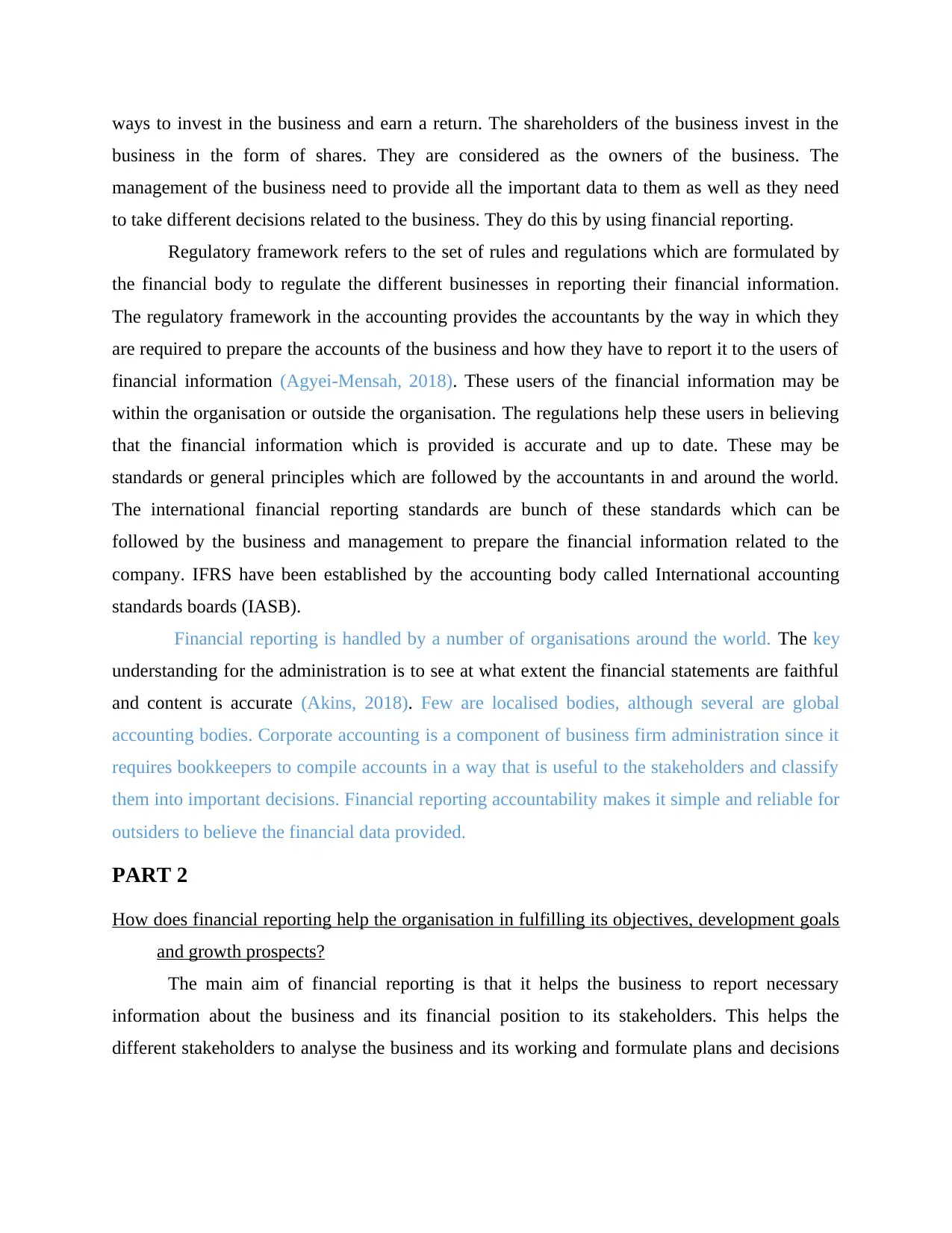
ways to invest in the business and earn a return. The shareholders of the business invest in the
business in the form of shares. They are considered as the owners of the business. The
management of the business need to provide all the important data to them as well as they need
to take different decisions related to the business. They do this by using financial reporting.
Regulatory framework refers to the set of rules and regulations which are formulated by
the financial body to regulate the different businesses in reporting their financial information.
The regulatory framework in the accounting provides the accountants by the way in which they
are required to prepare the accounts of the business and how they have to report it to the users of
financial information (Agyei-Mensah, 2018). These users of the financial information may be
within the organisation or outside the organisation. The regulations help these users in believing
that the financial information which is provided is accurate and up to date. These may be
standards or general principles which are followed by the accountants in and around the world.
The international financial reporting standards are bunch of these standards which can be
followed by the business and management to prepare the financial information related to the
company. IFRS have been established by the accounting body called International accounting
standards boards (IASB).
Financial reporting is handled by a number of organisations around the world. The key
understanding for the administration is to see at what extent the financial statements are faithful
and content is accurate (Akins, 2018). Few are localised bodies, although several are global
accounting bodies. Corporate accounting is a component of business firm administration since it
requires bookkeepers to compile accounts in a way that is useful to the stakeholders and classify
them into important decisions. Financial reporting accountability makes it simple and reliable for
outsiders to believe the financial data provided.
PART 2
How does financial reporting help the organisation in fulfilling its objectives, development goals
and growth prospects?
The main aim of financial reporting is that it helps the business to report necessary
information about the business and its financial position to its stakeholders. This helps the
different stakeholders to analyse the business and its working and formulate plans and decisions
business in the form of shares. They are considered as the owners of the business. The
management of the business need to provide all the important data to them as well as they need
to take different decisions related to the business. They do this by using financial reporting.
Regulatory framework refers to the set of rules and regulations which are formulated by
the financial body to regulate the different businesses in reporting their financial information.
The regulatory framework in the accounting provides the accountants by the way in which they
are required to prepare the accounts of the business and how they have to report it to the users of
financial information (Agyei-Mensah, 2018). These users of the financial information may be
within the organisation or outside the organisation. The regulations help these users in believing
that the financial information which is provided is accurate and up to date. These may be
standards or general principles which are followed by the accountants in and around the world.
The international financial reporting standards are bunch of these standards which can be
followed by the business and management to prepare the financial information related to the
company. IFRS have been established by the accounting body called International accounting
standards boards (IASB).
Financial reporting is handled by a number of organisations around the world. The key
understanding for the administration is to see at what extent the financial statements are faithful
and content is accurate (Akins, 2018). Few are localised bodies, although several are global
accounting bodies. Corporate accounting is a component of business firm administration since it
requires bookkeepers to compile accounts in a way that is useful to the stakeholders and classify
them into important decisions. Financial reporting accountability makes it simple and reliable for
outsiders to believe the financial data provided.
PART 2
How does financial reporting help the organisation in fulfilling its objectives, development goals
and growth prospects?
The main aim of financial reporting is that it helps the business to report necessary
information about the business and its financial position to its stakeholders. This helps the
different stakeholders to analyse the business and its working and formulate plans and decisions
Paraphrase This Document
Need a fresh take? Get an instant paraphrase of this document with our AI Paraphraser
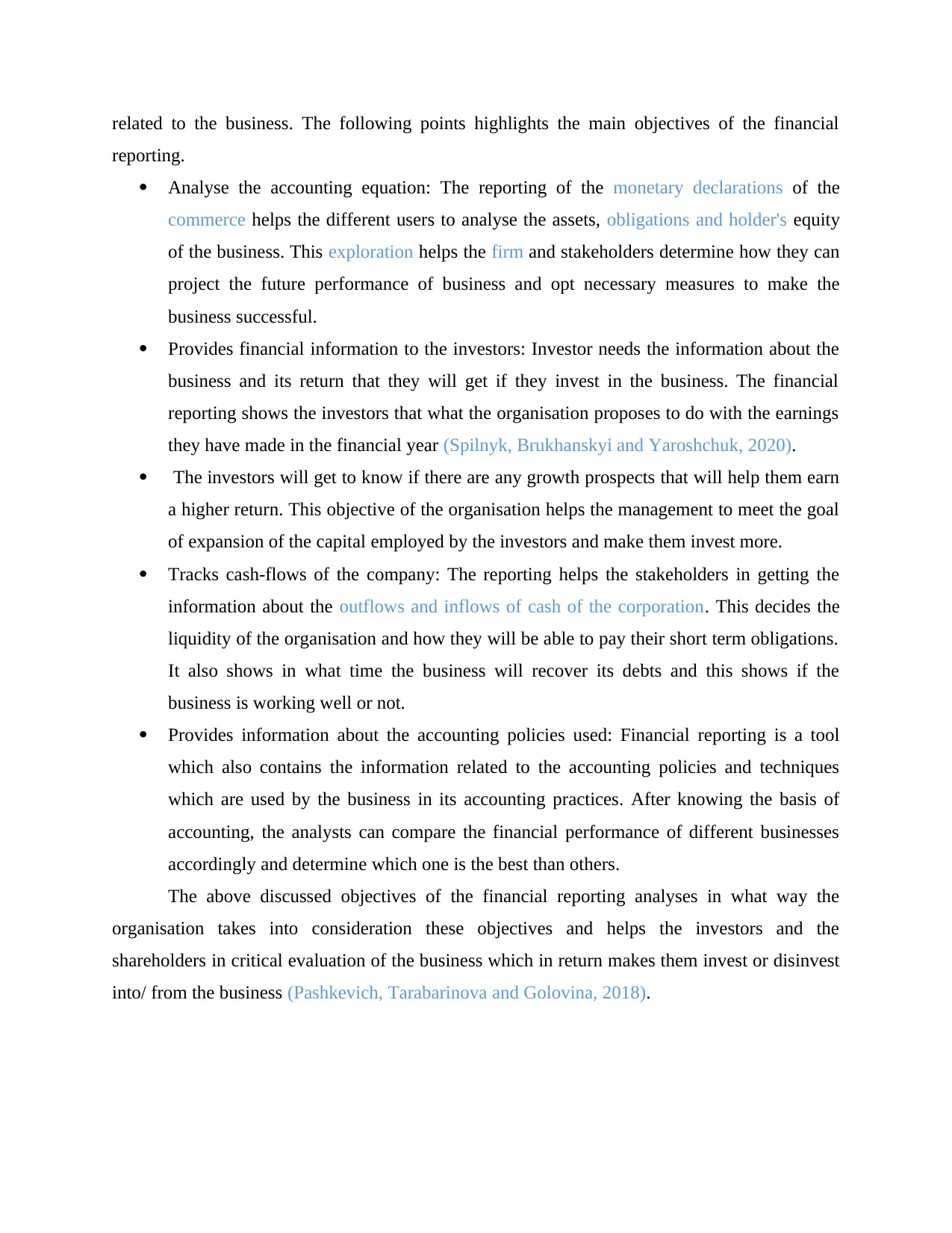
related to the business. The following points highlights the main objectives of the financial
reporting.
Analyse the accounting equation: The reporting of the monetary declarations of the
commerce helps the different users to analyse the assets, obligations and holder's equity
of the business. This exploration helps the firm and stakeholders determine how they can
project the future performance of business and opt necessary measures to make the
business successful.
Provides financial information to the investors: Investor needs the information about the
business and its return that they will get if they invest in the business. The financial
reporting shows the investors that what the organisation proposes to do with the earnings
they have made in the financial year (Spilnyk, Brukhanskyi and Yaroshchuk, 2020).
The investors will get to know if there are any growth prospects that will help them earn
a higher return. This objective of the organisation helps the management to meet the goal
of expansion of the capital employed by the investors and make them invest more.
Tracks cash-flows of the company: The reporting helps the stakeholders in getting the
information about the outflows and inflows of cash of the corporation. This decides the
liquidity of the organisation and how they will be able to pay their short term obligations.
It also shows in what time the business will recover its debts and this shows if the
business is working well or not.
Provides information about the accounting policies used: Financial reporting is a tool
which also contains the information related to the accounting policies and techniques
which are used by the business in its accounting practices. After knowing the basis of
accounting, the analysts can compare the financial performance of different businesses
accordingly and determine which one is the best than others.
The above discussed objectives of the financial reporting analyses in what way the
organisation takes into consideration these objectives and helps the investors and the
shareholders in critical evaluation of the business which in return makes them invest or disinvest
into/ from the business (Pashkevich, Tarabarinova and Golovina, 2018).
reporting.
Analyse the accounting equation: The reporting of the monetary declarations of the
commerce helps the different users to analyse the assets, obligations and holder's equity
of the business. This exploration helps the firm and stakeholders determine how they can
project the future performance of business and opt necessary measures to make the
business successful.
Provides financial information to the investors: Investor needs the information about the
business and its return that they will get if they invest in the business. The financial
reporting shows the investors that what the organisation proposes to do with the earnings
they have made in the financial year (Spilnyk, Brukhanskyi and Yaroshchuk, 2020).
The investors will get to know if there are any growth prospects that will help them earn
a higher return. This objective of the organisation helps the management to meet the goal
of expansion of the capital employed by the investors and make them invest more.
Tracks cash-flows of the company: The reporting helps the stakeholders in getting the
information about the outflows and inflows of cash of the corporation. This decides the
liquidity of the organisation and how they will be able to pay their short term obligations.
It also shows in what time the business will recover its debts and this shows if the
business is working well or not.
Provides information about the accounting policies used: Financial reporting is a tool
which also contains the information related to the accounting policies and techniques
which are used by the business in its accounting practices. After knowing the basis of
accounting, the analysts can compare the financial performance of different businesses
accordingly and determine which one is the best than others.
The above discussed objectives of the financial reporting analyses in what way the
organisation takes into consideration these objectives and helps the investors and the
shareholders in critical evaluation of the business which in return makes them invest or disinvest
into/ from the business (Pashkevich, Tarabarinova and Golovina, 2018).
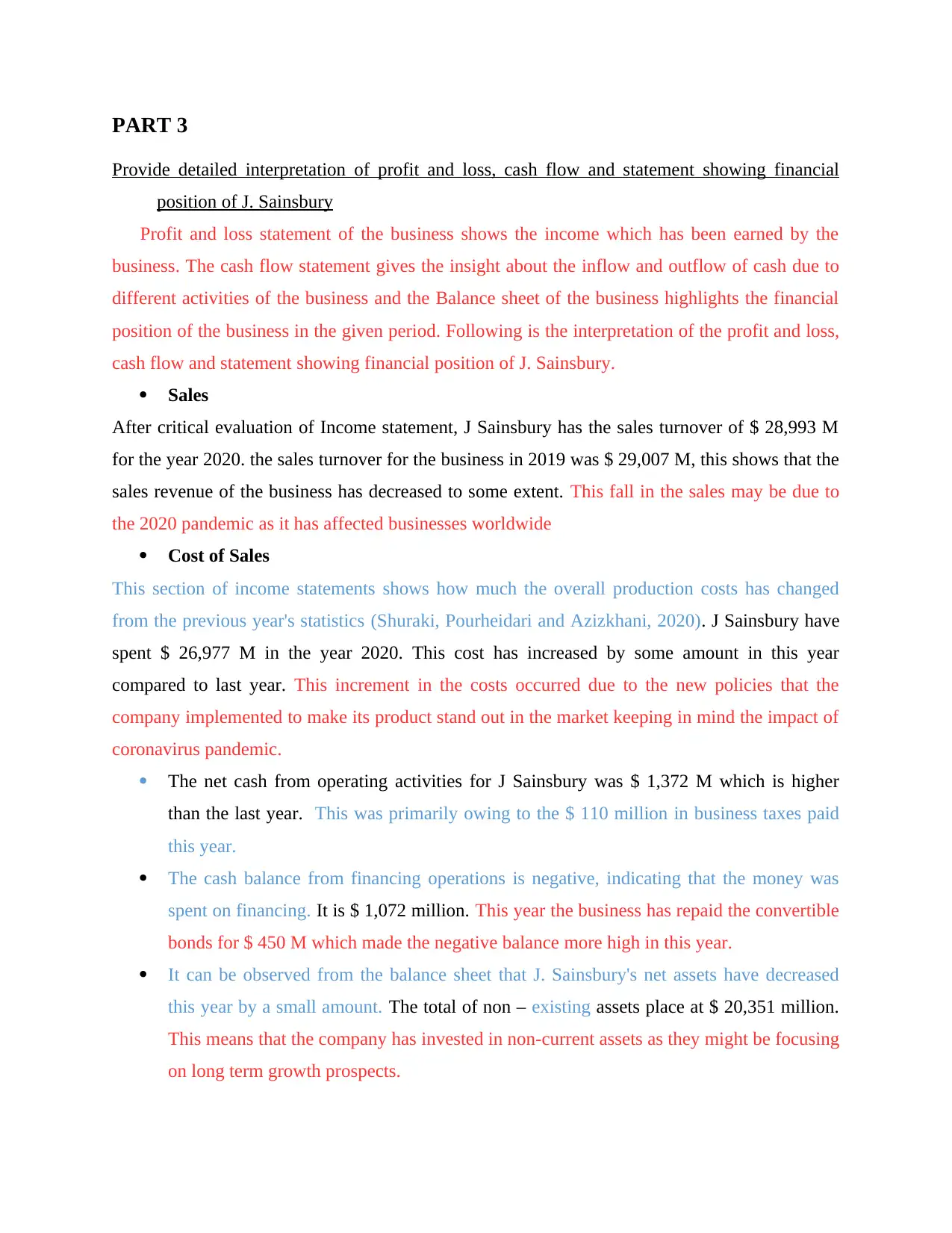
PART 3
Provide detailed interpretation of profit and loss, cash flow and statement showing financial
position of J. Sainsbury
Profit and loss statement of the business shows the income which has been earned by the
business. The cash flow statement gives the insight about the inflow and outflow of cash due to
different activities of the business and the Balance sheet of the business highlights the financial
position of the business in the given period. Following is the interpretation of the profit and loss,
cash flow and statement showing financial position of J. Sainsbury.
Sales
After critical evaluation of Income statement, J Sainsbury has the sales turnover of $ 28,993 M
for the year 2020. the sales turnover for the business in 2019 was $ 29,007 M, this shows that the
sales revenue of the business has decreased to some extent. This fall in the sales may be due to
the 2020 pandemic as it has affected businesses worldwide
Cost of Sales
This section of income statements shows how much the overall production costs has changed
from the previous year's statistics (Shuraki, Pourheidari and Azizkhani, 2020). J Sainsbury have
spent $ 26,977 M in the year 2020. This cost has increased by some amount in this year
compared to last year. This increment in the costs occurred due to the new policies that the
company implemented to make its product stand out in the market keeping in mind the impact of
coronavirus pandemic.
The net cash from operating activities for J Sainsbury was $ 1,372 M which is higher
than the last year. This was primarily owing to the $ 110 million in business taxes paid
this year.
The cash balance from financing operations is negative, indicating that the money was
spent on financing. It is $ 1,072 million. This year the business has repaid the convertible
bonds for $ 450 M which made the negative balance more high in this year.
It can be observed from the balance sheet that J. Sainsbury's net assets have decreased
this year by a small amount. The total of non – existing assets place at $ 20,351 million.
This means that the company has invested in non-current assets as they might be focusing
on long term growth prospects.
Provide detailed interpretation of profit and loss, cash flow and statement showing financial
position of J. Sainsbury
Profit and loss statement of the business shows the income which has been earned by the
business. The cash flow statement gives the insight about the inflow and outflow of cash due to
different activities of the business and the Balance sheet of the business highlights the financial
position of the business in the given period. Following is the interpretation of the profit and loss,
cash flow and statement showing financial position of J. Sainsbury.
Sales
After critical evaluation of Income statement, J Sainsbury has the sales turnover of $ 28,993 M
for the year 2020. the sales turnover for the business in 2019 was $ 29,007 M, this shows that the
sales revenue of the business has decreased to some extent. This fall in the sales may be due to
the 2020 pandemic as it has affected businesses worldwide
Cost of Sales
This section of income statements shows how much the overall production costs has changed
from the previous year's statistics (Shuraki, Pourheidari and Azizkhani, 2020). J Sainsbury have
spent $ 26,977 M in the year 2020. This cost has increased by some amount in this year
compared to last year. This increment in the costs occurred due to the new policies that the
company implemented to make its product stand out in the market keeping in mind the impact of
coronavirus pandemic.
The net cash from operating activities for J Sainsbury was $ 1,372 M which is higher
than the last year. This was primarily owing to the $ 110 million in business taxes paid
this year.
The cash balance from financing operations is negative, indicating that the money was
spent on financing. It is $ 1,072 million. This year the business has repaid the convertible
bonds for $ 450 M which made the negative balance more high in this year.
It can be observed from the balance sheet that J. Sainsbury's net assets have decreased
this year by a small amount. The total of non – existing assets place at $ 20,351 million.
This means that the company has invested in non-current assets as they might be focusing
on long term growth prospects.
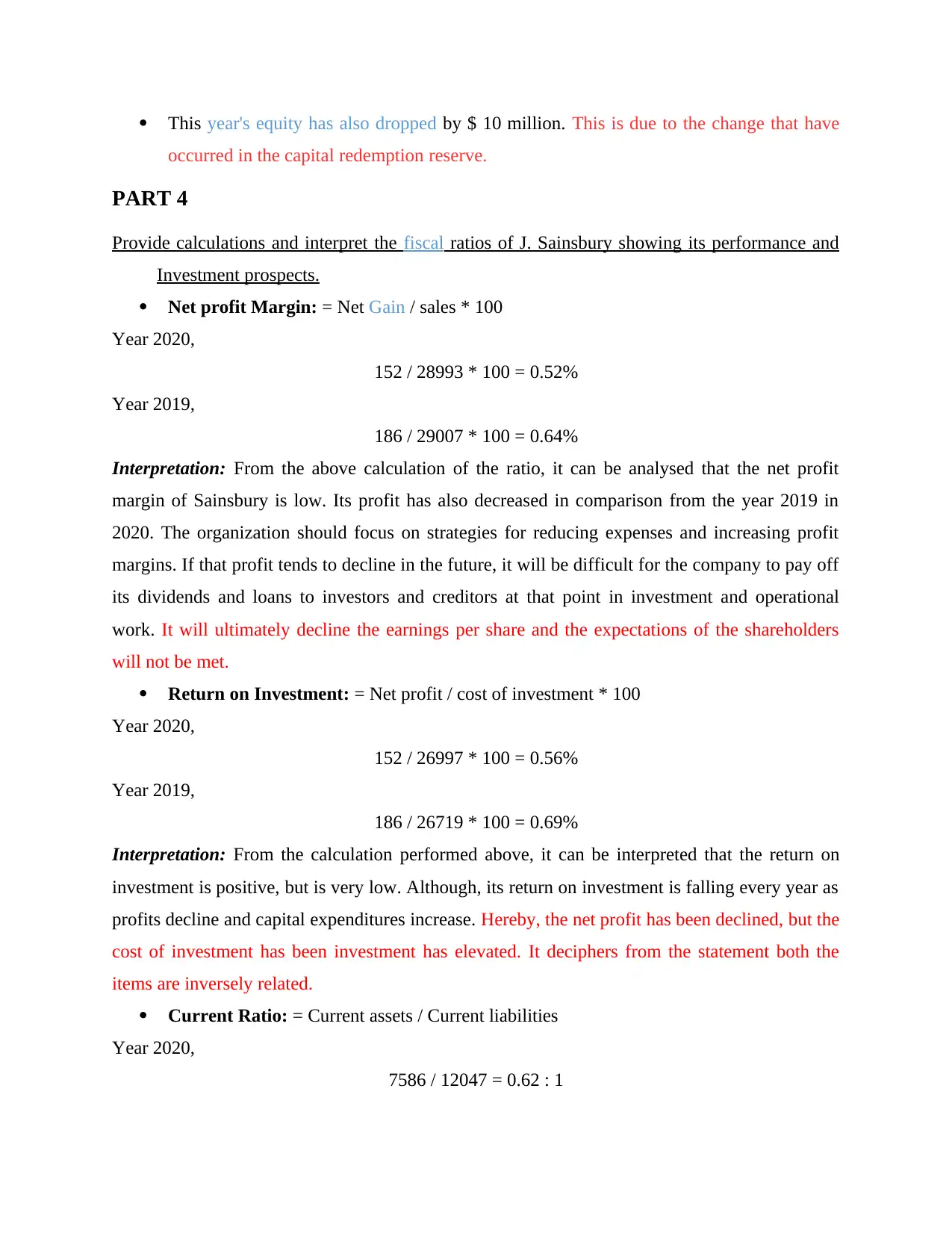
This year's equity has also dropped by $ 10 million. This is due to the change that have
occurred in the capital redemption reserve.
PART 4
Provide calculations and interpret the fiscal ratios of J. Sainsbury showing its performance and
Investment prospects.
Net profit Margin: = Net Gain / sales * 100
Year 2020,
152 / 28993 * 100 = 0.52%
Year 2019,
186 / 29007 * 100 = 0.64%
Interpretation: From the above calculation of the ratio, it can be analysed that the net profit
margin of Sainsbury is low. Its profit has also decreased in comparison from the year 2019 in
2020. The organization should focus on strategies for reducing expenses and increasing profit
margins. If that profit tends to decline in the future, it will be difficult for the company to pay off
its dividends and loans to investors and creditors at that point in investment and operational
work. It will ultimately decline the earnings per share and the expectations of the shareholders
will not be met.
Return on Investment: = Net profit / cost of investment * 100
Year 2020,
152 / 26997 * 100 = 0.56%
Year 2019,
186 / 26719 * 100 = 0.69%
Interpretation: From the calculation performed above, it can be interpreted that the return on
investment is positive, but is very low. Although, its return on investment is falling every year as
profits decline and capital expenditures increase. Hereby, the net profit has been declined, but the
cost of investment has been investment has elevated. It deciphers from the statement both the
items are inversely related.
Current Ratio: = Current assets / Current liabilities
Year 2020,
7586 / 12047 = 0.62 : 1
occurred in the capital redemption reserve.
PART 4
Provide calculations and interpret the fiscal ratios of J. Sainsbury showing its performance and
Investment prospects.
Net profit Margin: = Net Gain / sales * 100
Year 2020,
152 / 28993 * 100 = 0.52%
Year 2019,
186 / 29007 * 100 = 0.64%
Interpretation: From the above calculation of the ratio, it can be analysed that the net profit
margin of Sainsbury is low. Its profit has also decreased in comparison from the year 2019 in
2020. The organization should focus on strategies for reducing expenses and increasing profit
margins. If that profit tends to decline in the future, it will be difficult for the company to pay off
its dividends and loans to investors and creditors at that point in investment and operational
work. It will ultimately decline the earnings per share and the expectations of the shareholders
will not be met.
Return on Investment: = Net profit / cost of investment * 100
Year 2020,
152 / 26997 * 100 = 0.56%
Year 2019,
186 / 26719 * 100 = 0.69%
Interpretation: From the calculation performed above, it can be interpreted that the return on
investment is positive, but is very low. Although, its return on investment is falling every year as
profits decline and capital expenditures increase. Hereby, the net profit has been declined, but the
cost of investment has been investment has elevated. It deciphers from the statement both the
items are inversely related.
Current Ratio: = Current assets / Current liabilities
Year 2020,
7586 / 12047 = 0.62 : 1
Secure Best Marks with AI Grader
Need help grading? Try our AI Grader for instant feedback on your assignments.
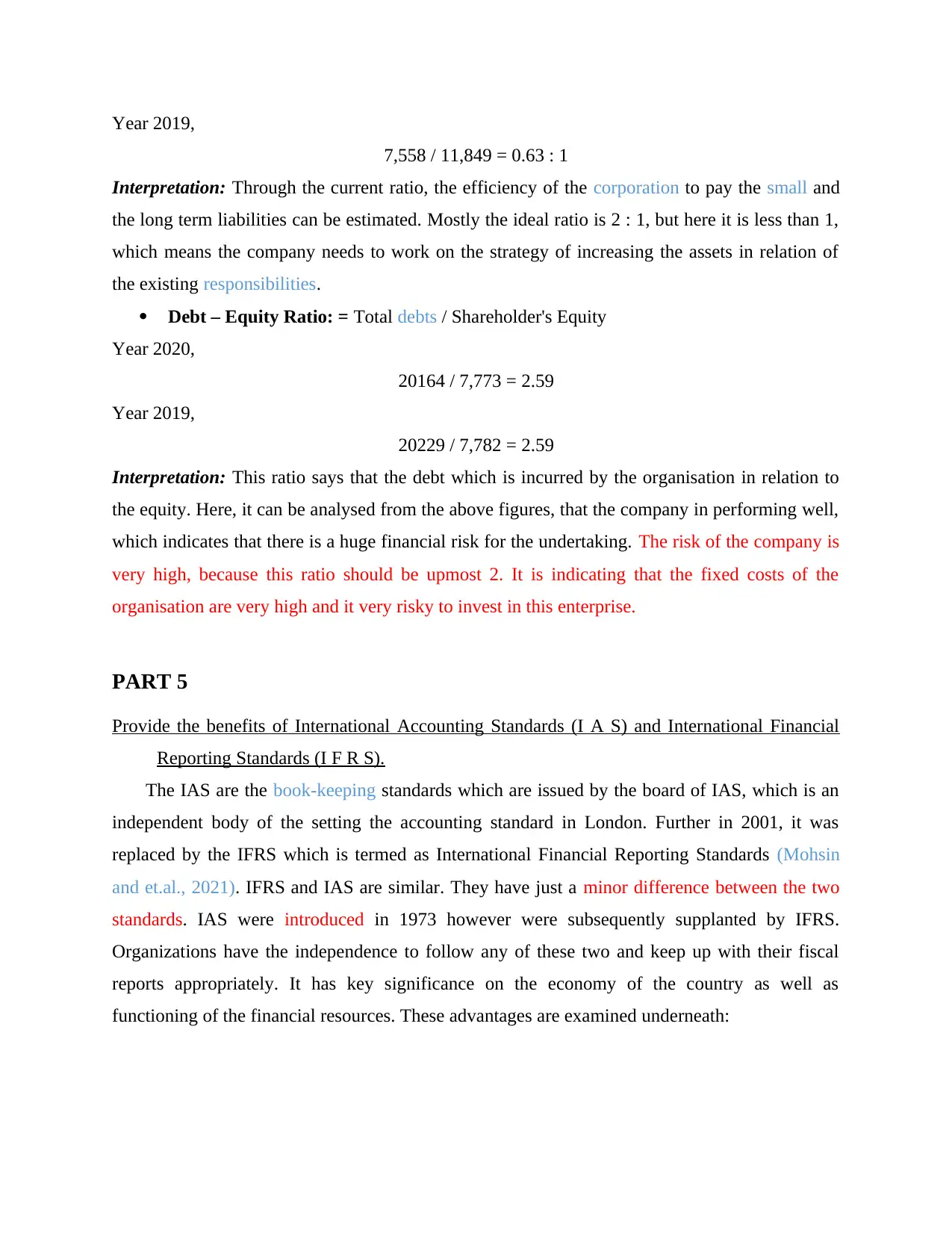
Year 2019,
7,558 / 11,849 = 0.63 : 1
Interpretation: Through the current ratio, the efficiency of the corporation to pay the small and
the long term liabilities can be estimated. Mostly the ideal ratio is 2 : 1, but here it is less than 1,
which means the company needs to work on the strategy of increasing the assets in relation of
the existing responsibilities.
Debt – Equity Ratio: = Total debts / Shareholder's Equity
Year 2020,
20164 / 7,773 = 2.59
Year 2019,
20229 / 7,782 = 2.59
Interpretation: This ratio says that the debt which is incurred by the organisation in relation to
the equity. Here, it can be analysed from the above figures, that the company in performing well,
which indicates that there is a huge financial risk for the undertaking. The risk of the company is
very high, because this ratio should be upmost 2. It is indicating that the fixed costs of the
organisation are very high and it very risky to invest in this enterprise.
PART 5
Provide the benefits of International Accounting Standards (I A S) and International Financial
Reporting Standards (I F R S).
The IAS are the book-keeping standards which are issued by the board of IAS, which is an
independent body of the setting the accounting standard in London. Further in 2001, it was
replaced by the IFRS which is termed as International Financial Reporting Standards (Mohsin
and et.al., 2021). IFRS and IAS are similar. They have just a minor difference between the two
standards. IAS were introduced in 1973 however were subsequently supplanted by IFRS.
Organizations have the independence to follow any of these two and keep up with their fiscal
reports appropriately. It has key significance on the economy of the country as well as
functioning of the financial resources. These advantages are examined underneath:
7,558 / 11,849 = 0.63 : 1
Interpretation: Through the current ratio, the efficiency of the corporation to pay the small and
the long term liabilities can be estimated. Mostly the ideal ratio is 2 : 1, but here it is less than 1,
which means the company needs to work on the strategy of increasing the assets in relation of
the existing responsibilities.
Debt – Equity Ratio: = Total debts / Shareholder's Equity
Year 2020,
20164 / 7,773 = 2.59
Year 2019,
20229 / 7,782 = 2.59
Interpretation: This ratio says that the debt which is incurred by the organisation in relation to
the equity. Here, it can be analysed from the above figures, that the company in performing well,
which indicates that there is a huge financial risk for the undertaking. The risk of the company is
very high, because this ratio should be upmost 2. It is indicating that the fixed costs of the
organisation are very high and it very risky to invest in this enterprise.
PART 5
Provide the benefits of International Accounting Standards (I A S) and International Financial
Reporting Standards (I F R S).
The IAS are the book-keeping standards which are issued by the board of IAS, which is an
independent body of the setting the accounting standard in London. Further in 2001, it was
replaced by the IFRS which is termed as International Financial Reporting Standards (Mohsin
and et.al., 2021). IFRS and IAS are similar. They have just a minor difference between the two
standards. IAS were introduced in 1973 however were subsequently supplanted by IFRS.
Organizations have the independence to follow any of these two and keep up with their fiscal
reports appropriately. It has key significance on the economy of the country as well as
functioning of the financial resources. These advantages are examined underneath:

Taking on the IFRS assists an economy with expanding the development of its worldwide
business. By having realized the worldwide norms needed to be followed, organizations
can expand into new domains and become a global corporation.
IFRS boosts the investors to contribute and predominantly the unfamiliar investors as
they know about the worldwide bookkeeping principles which can decipher the monetary
information as needs be.
Following a typical arrangement of accounting principles to get ready the financial
reports help the investors better comprehend the investment threats and the opportunities
in the global market.
All around the world acknowledged bookkeeping guidelines will sort belief in the
behaviours of unacquainted investors and an industry can nurture capital from unaware
commercial sectors at a lesser cost (Mnif and Znazen, 2020).
By following the IFRS and IAS structures general principles that are relevant to different
wards with negligible government mediation as these are applied globally.
Following similar bookkeeping practices offers the bookkeeping experts more vocation
openings on the universe.
The organisation who do not apply these standards in their financial reporting can face
the legal compliance and will not be eligible to take loans easily.
If the company harmonizes the accounting rule and procedures with the help of these
standards, it will enable it to establish the subsidiaries in other countries and need not to
change the policies at the time of consolidation of accounts of group companies.
PART 6
Discuss the models of monetary reporting and auditing.
Financial reporting models are various models addressing a true monetary circumstance which
are made to more voluntarily comprehend the need of fiscal reporting and evaluating and helps
the administration gauge the expenses and undertaking the benefits of a proposed project. The
experts of the financial data utilize fiscal models to assess the impact of a financial strategy
change or some other occasion on a company’s stock (Dimitras, Gaganis and Pasiouras, 2018).
Some of the models are explained under:
business. By having realized the worldwide norms needed to be followed, organizations
can expand into new domains and become a global corporation.
IFRS boosts the investors to contribute and predominantly the unfamiliar investors as
they know about the worldwide bookkeeping principles which can decipher the monetary
information as needs be.
Following a typical arrangement of accounting principles to get ready the financial
reports help the investors better comprehend the investment threats and the opportunities
in the global market.
All around the world acknowledged bookkeeping guidelines will sort belief in the
behaviours of unacquainted investors and an industry can nurture capital from unaware
commercial sectors at a lesser cost (Mnif and Znazen, 2020).
By following the IFRS and IAS structures general principles that are relevant to different
wards with negligible government mediation as these are applied globally.
Following similar bookkeeping practices offers the bookkeeping experts more vocation
openings on the universe.
The organisation who do not apply these standards in their financial reporting can face
the legal compliance and will not be eligible to take loans easily.
If the company harmonizes the accounting rule and procedures with the help of these
standards, it will enable it to establish the subsidiaries in other countries and need not to
change the policies at the time of consolidation of accounts of group companies.
PART 6
Discuss the models of monetary reporting and auditing.
Financial reporting models are various models addressing a true monetary circumstance which
are made to more voluntarily comprehend the need of fiscal reporting and evaluating and helps
the administration gauge the expenses and undertaking the benefits of a proposed project. The
experts of the financial data utilize fiscal models to assess the impact of a financial strategy
change or some other occasion on a company’s stock (Dimitras, Gaganis and Pasiouras, 2018).
Some of the models are explained under:
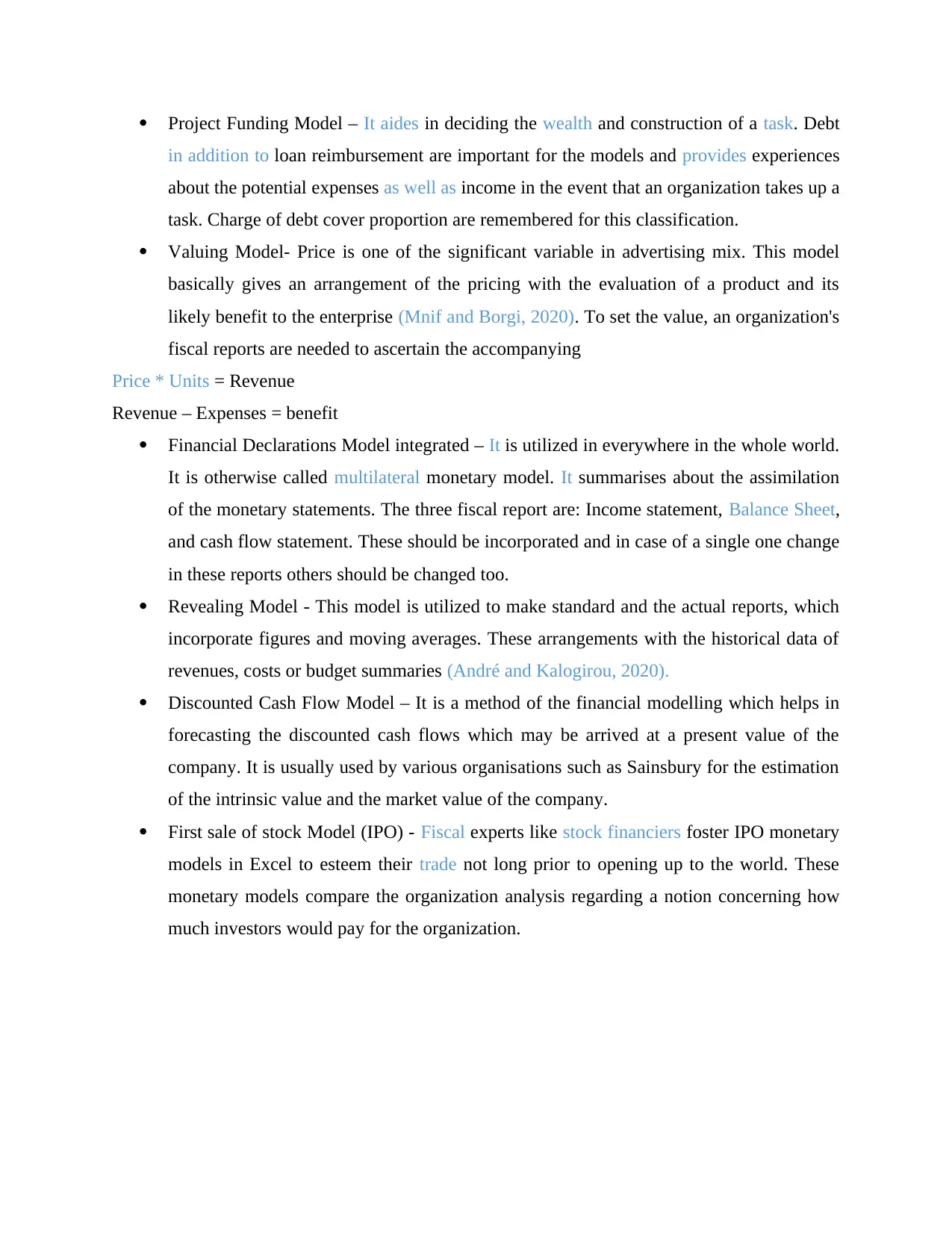
Project Funding Model – It aides in deciding the wealth and construction of a task. Debt
in addition to loan reimbursement are important for the models and provides experiences
about the potential expenses as well as income in the event that an organization takes up a
task. Charge of debt cover proportion are remembered for this classification.
Valuing Model- Price is one of the significant variable in advertising mix. This model
basically gives an arrangement of the pricing with the evaluation of a product and its
likely benefit to the enterprise (Mnif and Borgi, 2020). To set the value, an organization's
fiscal reports are needed to ascertain the accompanying
Price * Units = Revenue
Revenue – Expenses = benefit
Financial Declarations Model integrated – It is utilized in everywhere in the whole world.
It is otherwise called multilateral monetary model. It summarises about the assimilation
of the monetary statements. The three fiscal report are: Income statement, Balance Sheet,
and cash flow statement. These should be incorporated and in case of a single one change
in these reports others should be changed too.
Revealing Model - This model is utilized to make standard and the actual reports, which
incorporate figures and moving averages. These arrangements with the historical data of
revenues, costs or budget summaries (André and Kalogirou, 2020).
Discounted Cash Flow Model – It is a method of the financial modelling which helps in
forecasting the discounted cash flows which may be arrived at a present value of the
company. It is usually used by various organisations such as Sainsbury for the estimation
of the intrinsic value and the market value of the company.
First sale of stock Model (IPO) - Fiscal experts like stock financiers foster IPO monetary
models in Excel to esteem their trade not long prior to opening up to the world. These
monetary models compare the organization analysis regarding a notion concerning how
much investors would pay for the organization.
in addition to loan reimbursement are important for the models and provides experiences
about the potential expenses as well as income in the event that an organization takes up a
task. Charge of debt cover proportion are remembered for this classification.
Valuing Model- Price is one of the significant variable in advertising mix. This model
basically gives an arrangement of the pricing with the evaluation of a product and its
likely benefit to the enterprise (Mnif and Borgi, 2020). To set the value, an organization's
fiscal reports are needed to ascertain the accompanying
Price * Units = Revenue
Revenue – Expenses = benefit
Financial Declarations Model integrated – It is utilized in everywhere in the whole world.
It is otherwise called multilateral monetary model. It summarises about the assimilation
of the monetary statements. The three fiscal report are: Income statement, Balance Sheet,
and cash flow statement. These should be incorporated and in case of a single one change
in these reports others should be changed too.
Revealing Model - This model is utilized to make standard and the actual reports, which
incorporate figures and moving averages. These arrangements with the historical data of
revenues, costs or budget summaries (André and Kalogirou, 2020).
Discounted Cash Flow Model – It is a method of the financial modelling which helps in
forecasting the discounted cash flows which may be arrived at a present value of the
company. It is usually used by various organisations such as Sainsbury for the estimation
of the intrinsic value and the market value of the company.
First sale of stock Model (IPO) - Fiscal experts like stock financiers foster IPO monetary
models in Excel to esteem their trade not long prior to opening up to the world. These
monetary models compare the organization analysis regarding a notion concerning how
much investors would pay for the organization.
Paraphrase This Document
Need a fresh take? Get an instant paraphrase of this document with our AI Paraphraser
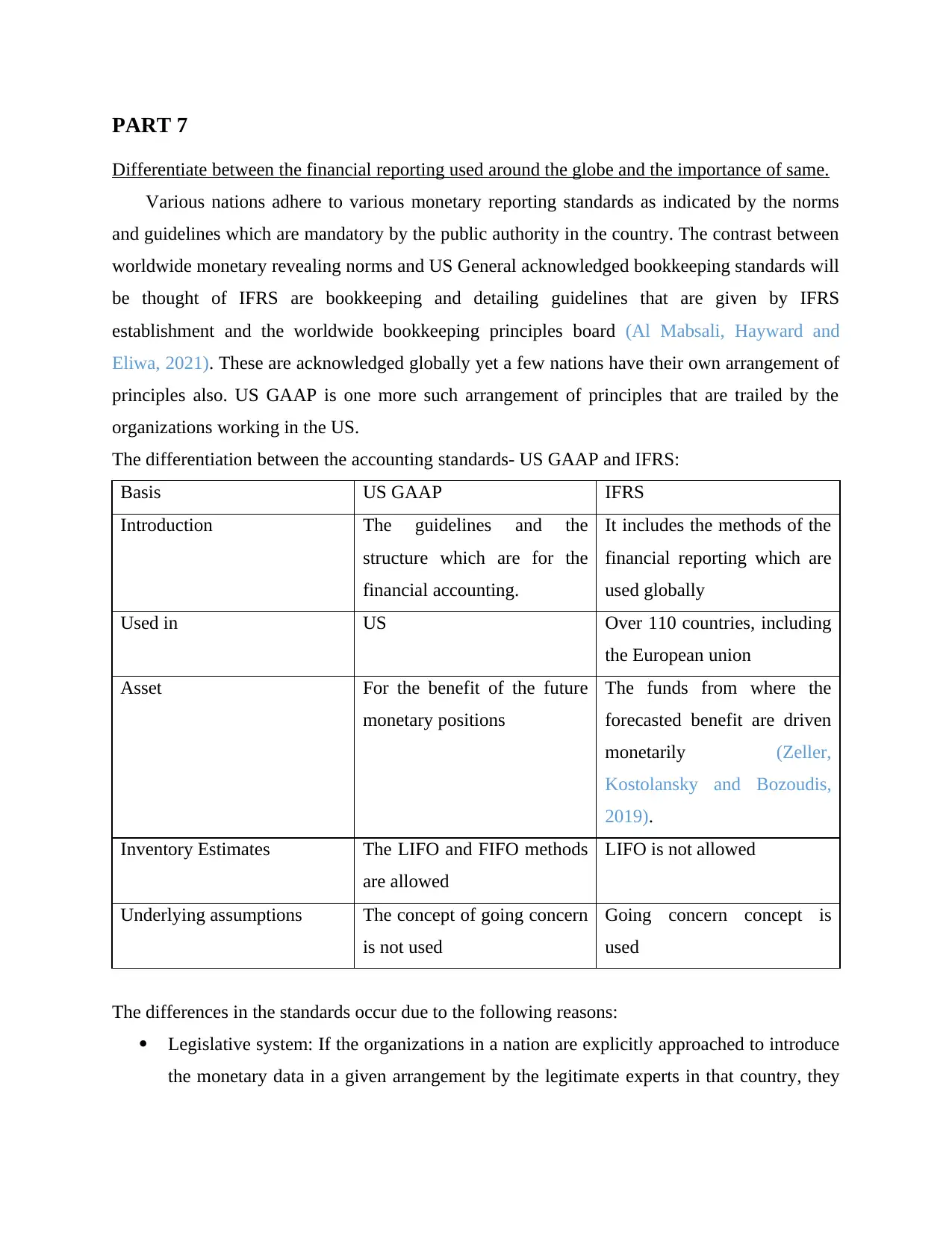
PART 7
Differentiate between the financial reporting used around the globe and the importance of same.
Various nations adhere to various monetary reporting standards as indicated by the norms
and guidelines which are mandatory by the public authority in the country. The contrast between
worldwide monetary revealing norms and US General acknowledged bookkeeping standards will
be thought of IFRS are bookkeeping and detailing guidelines that are given by IFRS
establishment and the worldwide bookkeeping principles board (Al Mabsali, Hayward and
Eliwa, 2021). These are acknowledged globally yet a few nations have their own arrangement of
principles also. US GAAP is one more such arrangement of principles that are trailed by the
organizations working in the US.
The differentiation between the accounting standards- US GAAP and IFRS:
Basis US GAAP IFRS
Introduction The guidelines and the
structure which are for the
financial accounting.
It includes the methods of the
financial reporting which are
used globally
Used in US Over 110 countries, including
the European union
Asset For the benefit of the future
monetary positions
The funds from where the
forecasted benefit are driven
monetarily (Zeller,
Kostolansky and Bozoudis,
2019).
Inventory Estimates The LIFO and FIFO methods
are allowed
LIFO is not allowed
Underlying assumptions The concept of going concern
is not used
Going concern concept is
used
The differences in the standards occur due to the following reasons:
Legislative system: If the organizations in a nation are explicitly approached to introduce
the monetary data in a given arrangement by the legitimate experts in that country, they
Differentiate between the financial reporting used around the globe and the importance of same.
Various nations adhere to various monetary reporting standards as indicated by the norms
and guidelines which are mandatory by the public authority in the country. The contrast between
worldwide monetary revealing norms and US General acknowledged bookkeeping standards will
be thought of IFRS are bookkeeping and detailing guidelines that are given by IFRS
establishment and the worldwide bookkeeping principles board (Al Mabsali, Hayward and
Eliwa, 2021). These are acknowledged globally yet a few nations have their own arrangement of
principles also. US GAAP is one more such arrangement of principles that are trailed by the
organizations working in the US.
The differentiation between the accounting standards- US GAAP and IFRS:
Basis US GAAP IFRS
Introduction The guidelines and the
structure which are for the
financial accounting.
It includes the methods of the
financial reporting which are
used globally
Used in US Over 110 countries, including
the European union
Asset For the benefit of the future
monetary positions
The funds from where the
forecasted benefit are driven
monetarily (Zeller,
Kostolansky and Bozoudis,
2019).
Inventory Estimates The LIFO and FIFO methods
are allowed
LIFO is not allowed
Underlying assumptions The concept of going concern
is not used
Going concern concept is
used
The differences in the standards occur due to the following reasons:
Legislative system: If the organizations in a nation are explicitly approached to introduce
the monetary data in a given arrangement by the legitimate experts in that country, they

need to adhere to these guidelines and consequently it makes an alternate basis of the
reporting all over the globe (Nurunnabi, 2021).
Tax assessment: In certain nations, distributed monetary records frames the premise of
expense computation yet in others, financial reports are adapted to tax purposes because
of different regulation laid down by the government.
Political and Economic Ties: With it, rules and guidelines can be passed to country then
onto the other nation, to have improved analysis otherwise simpler exchange of experts to
work and foster the supplementary country (Yamani and Hussainey, 2021). Inflation: If it is predicted that the nation will face the inflation in the future, the
bookkeeping bodies should consider modification the change of the amounts of the
historical cost. Additionally, changing pay for inflation is likewise significant for the
calculation of tax.
Significance of financial reporting:
It helps the clients of monetary data to follow pattern or trends of the business and work
so that they can procure the majority of the advantages.
By having full information about the organization's liquidity, the administration has the
ability to deal with its obligations all the more effectively (Ballas and et.al., 2019).
The information of the fiscal reports assists with estimating the risks which can be borne
by the expecting changes in the economic situations.
CONCLUSION
From the above description, it can be inferred that IFRS is a significant perspective in the
sphere of bookkeeping. IFRS are convention of principles and guidelines that are to be taken up
by the association while making and revealing the budget reports to the various clients.
Administrative structure assists the experts with having a superior understanding on to what
exactly everything is needed to be done to accomplish the objectives. Bookkeeping standards and
administrative system is the premise of getting ready and revealing the budget reports and data to
the recognized partners. Each client of the monetary data involves it in their own specific manner
and seeing, subsequently it gets significant for the bookkeepers to set up the records so that
nobody experiences issues getting them and can get full advantages from something similar. This
report has discussed how IFRS is significant for various reasons, idea of bookkeeping
reporting all over the globe (Nurunnabi, 2021).
Tax assessment: In certain nations, distributed monetary records frames the premise of
expense computation yet in others, financial reports are adapted to tax purposes because
of different regulation laid down by the government.
Political and Economic Ties: With it, rules and guidelines can be passed to country then
onto the other nation, to have improved analysis otherwise simpler exchange of experts to
work and foster the supplementary country (Yamani and Hussainey, 2021). Inflation: If it is predicted that the nation will face the inflation in the future, the
bookkeeping bodies should consider modification the change of the amounts of the
historical cost. Additionally, changing pay for inflation is likewise significant for the
calculation of tax.
Significance of financial reporting:
It helps the clients of monetary data to follow pattern or trends of the business and work
so that they can procure the majority of the advantages.
By having full information about the organization's liquidity, the administration has the
ability to deal with its obligations all the more effectively (Ballas and et.al., 2019).
The information of the fiscal reports assists with estimating the risks which can be borne
by the expecting changes in the economic situations.
CONCLUSION
From the above description, it can be inferred that IFRS is a significant perspective in the
sphere of bookkeeping. IFRS are convention of principles and guidelines that are to be taken up
by the association while making and revealing the budget reports to the various clients.
Administrative structure assists the experts with having a superior understanding on to what
exactly everything is needed to be done to accomplish the objectives. Bookkeeping standards and
administrative system is the premise of getting ready and revealing the budget reports and data to
the recognized partners. Each client of the monetary data involves it in their own specific manner
and seeing, subsequently it gets significant for the bookkeepers to set up the records so that
nobody experiences issues getting them and can get full advantages from something similar. This
report has discussed how IFRS is significant for various reasons, idea of bookkeeping

proportions and translation of fiscal summaries while taking up Unilever as the base organization
for doing this report.
for doing this report.
Secure Best Marks with AI Grader
Need help grading? Try our AI Grader for instant feedback on your assignments.

REFERENCES
Books and Journals
Agyei-Mensah, B.K., 2018. Impact of corporate governance attributes and financial reporting
lag on corporate financial performance. African Journal of Economic and Management
Studies.
Akins, B., 2018. Financial reporting quality and uncertainty about credit risk among ratings
agencies. The Accounting Review. 93(4). pp.1-22.
Al Mabsali, Y.K., Hayward, R. and Eliwa, Y., 2021. Managerial tools used to meet or beat
analyst forecasts: Evidence from the UK. Journal of International Accounting, Auditing
and Taxation. 43. p.100383.
André, P. and Kalogirou, F., 2020, July. IFRS adoption by UK unlisted firms: subsidiary-versus
group-level incentives. In Accounting Forum (Vol. 44, No. 3, pp. 215-237). Routledge.
Ballas, P. and et.al., 2019. Quality of financial reporting under IFRS and corporate governance
influence: Evidence from the Greek banking sector during crisis. Journal of
Governance and Regulation/Volume. 8(4).
Dimitras, A.I., Gaganis, C. and Pasiouras, F., 2018. Financial reporting standards' change and
the efficiency measures of EU banks. International Review of Financial Analysis. 59.
pp.223-233.
Habib, A. and et.al., 2018. Political connections, financial reporting and auditing: Survey of the
empirical literature. Journal of International Accounting, Auditing and Taxation. 31.
pp.37-51.
Mnif, Y. and Borgi, H., 2020. The association between corporate governance mechanisms and
compliance with IFRS mandatory disclosure requirements: evidence from 12 African
countries. Corporate Governance: The International Journal of Business in Society.
Mnif, Y. and Znazen, O., 2020. Corporate governance and compliance with IFRS 7: The case of
financial institutions listed in Canada. Managerial Auditing Journal.
Mohsin, M. and et.al., 2021. The evaluation of efficiency and value addition of IFRS
endorsement towards earnings timeliness disclosure. International Journal of Finance
& Economics. 26(2). pp.1793-1807.
Nurunnabi, M., 2021. Theory of International Financial Reporting Standards (IFRS)
Implementation. In International Financial Reporting Standards Implementation: A
Global Experience. Emerald Publishing Limited.
Pashkevich, N.V., Tarabarinova, T.A. and Golovina, E.I., 2018. Problems of reflecting
information on subsoil assets in International Financial Reporting Standards. Academy
of Strategic Management Journal. 17(3). pp.1-9.
Shuraki, M.G., Pourheidari, O. and Azizkhani, M., 2020. Accounting comparability, financial
reporting quality and audit opinions: evidence from Iran. Asian Review of Accounting.
Spilnyk, I., Brukhanskyi, R. and Yaroshchuk, O., 2020, September. Accounting and Financial
Reporting System in the Digital Economy. In 2020 10th International Conference on
Advanced Computer Information Technologies (ACIT) (pp. 581-584). IEEE.
Venturelli, A. and et.al., 2018. The state of art of corporate social disclosure before the
introduction of non-financial reporting directive: A cross country analysis. Social
responsibility journal.
Books and Journals
Agyei-Mensah, B.K., 2018. Impact of corporate governance attributes and financial reporting
lag on corporate financial performance. African Journal of Economic and Management
Studies.
Akins, B., 2018. Financial reporting quality and uncertainty about credit risk among ratings
agencies. The Accounting Review. 93(4). pp.1-22.
Al Mabsali, Y.K., Hayward, R. and Eliwa, Y., 2021. Managerial tools used to meet or beat
analyst forecasts: Evidence from the UK. Journal of International Accounting, Auditing
and Taxation. 43. p.100383.
André, P. and Kalogirou, F., 2020, July. IFRS adoption by UK unlisted firms: subsidiary-versus
group-level incentives. In Accounting Forum (Vol. 44, No. 3, pp. 215-237). Routledge.
Ballas, P. and et.al., 2019. Quality of financial reporting under IFRS and corporate governance
influence: Evidence from the Greek banking sector during crisis. Journal of
Governance and Regulation/Volume. 8(4).
Dimitras, A.I., Gaganis, C. and Pasiouras, F., 2018. Financial reporting standards' change and
the efficiency measures of EU banks. International Review of Financial Analysis. 59.
pp.223-233.
Habib, A. and et.al., 2018. Political connections, financial reporting and auditing: Survey of the
empirical literature. Journal of International Accounting, Auditing and Taxation. 31.
pp.37-51.
Mnif, Y. and Borgi, H., 2020. The association between corporate governance mechanisms and
compliance with IFRS mandatory disclosure requirements: evidence from 12 African
countries. Corporate Governance: The International Journal of Business in Society.
Mnif, Y. and Znazen, O., 2020. Corporate governance and compliance with IFRS 7: The case of
financial institutions listed in Canada. Managerial Auditing Journal.
Mohsin, M. and et.al., 2021. The evaluation of efficiency and value addition of IFRS
endorsement towards earnings timeliness disclosure. International Journal of Finance
& Economics. 26(2). pp.1793-1807.
Nurunnabi, M., 2021. Theory of International Financial Reporting Standards (IFRS)
Implementation. In International Financial Reporting Standards Implementation: A
Global Experience. Emerald Publishing Limited.
Pashkevich, N.V., Tarabarinova, T.A. and Golovina, E.I., 2018. Problems of reflecting
information on subsoil assets in International Financial Reporting Standards. Academy
of Strategic Management Journal. 17(3). pp.1-9.
Shuraki, M.G., Pourheidari, O. and Azizkhani, M., 2020. Accounting comparability, financial
reporting quality and audit opinions: evidence from Iran. Asian Review of Accounting.
Spilnyk, I., Brukhanskyi, R. and Yaroshchuk, O., 2020, September. Accounting and Financial
Reporting System in the Digital Economy. In 2020 10th International Conference on
Advanced Computer Information Technologies (ACIT) (pp. 581-584). IEEE.
Venturelli, A. and et.al., 2018. The state of art of corporate social disclosure before the
introduction of non-financial reporting directive: A cross country analysis. Social
responsibility journal.
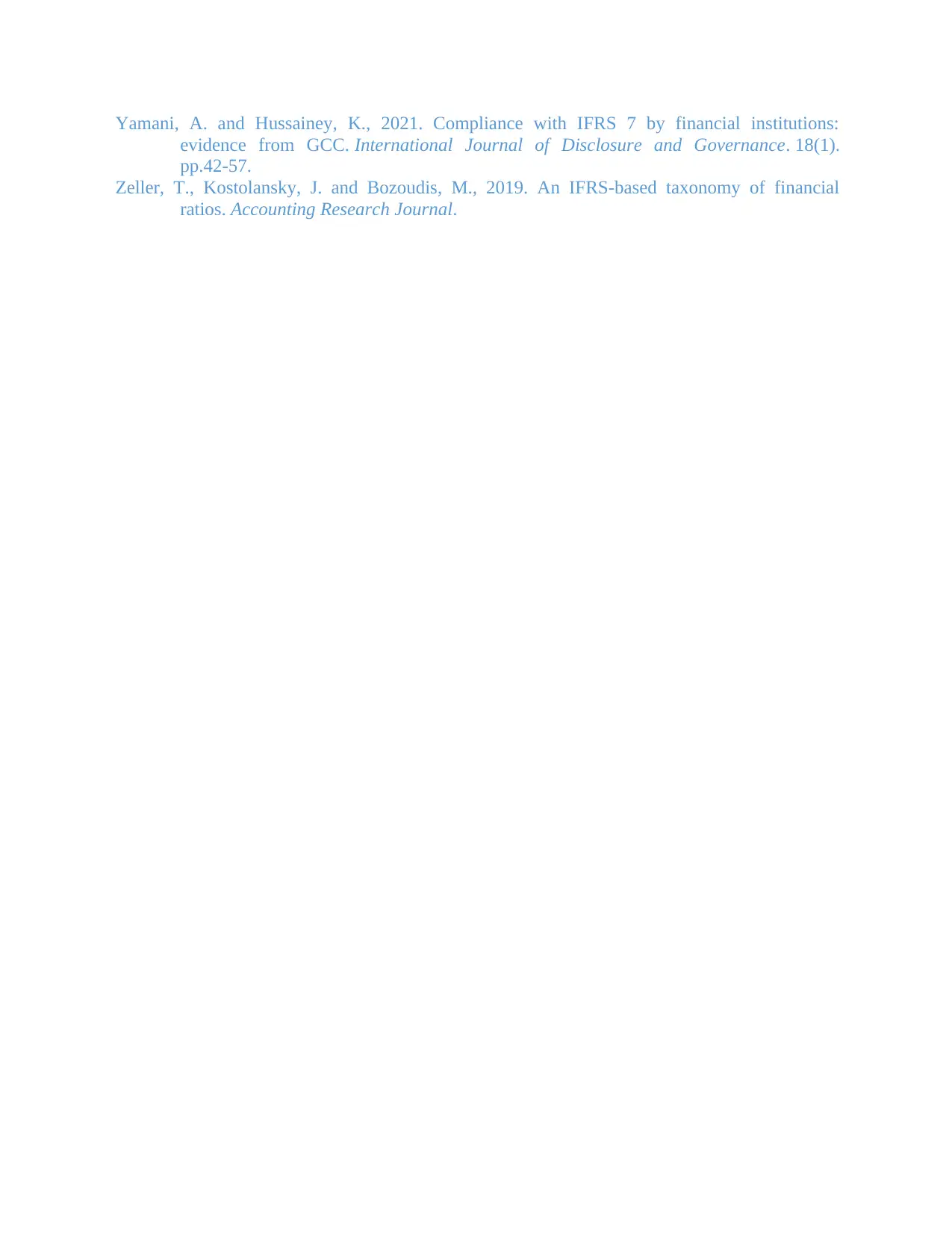
Yamani, A. and Hussainey, K., 2021. Compliance with IFRS 7 by financial institutions:
evidence from GCC. International Journal of Disclosure and Governance. 18(1).
pp.42-57.
Zeller, T., Kostolansky, J. and Bozoudis, M., 2019. An IFRS-based taxonomy of financial
ratios. Accounting Research Journal.
evidence from GCC. International Journal of Disclosure and Governance. 18(1).
pp.42-57.
Zeller, T., Kostolansky, J. and Bozoudis, M., 2019. An IFRS-based taxonomy of financial
ratios. Accounting Research Journal.
1 out of 15
![[object Object]](/_next/static/media/star-bottom.7253800d.svg)





